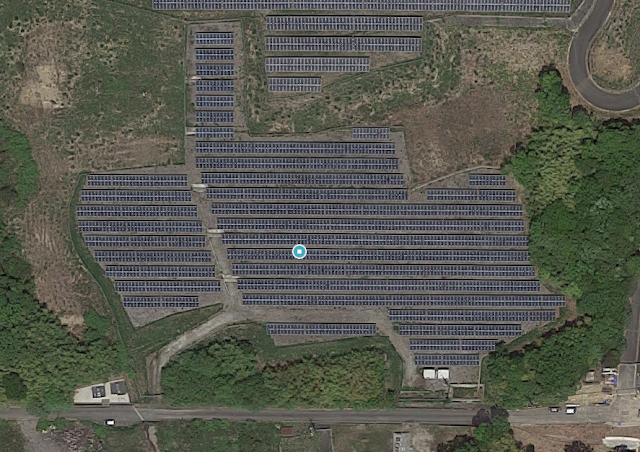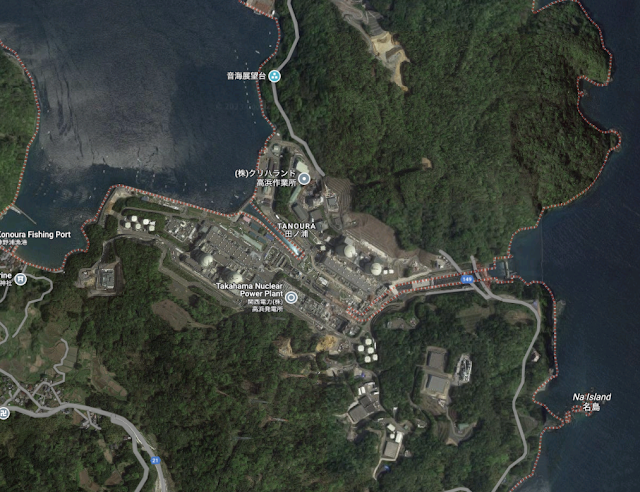My ride started as a solar PV tour, and ended up as a nuclear tour. Kind of like Japan's post-2011 energy policy? I don't actually have any photos of the sites I mention below ... because they were not close enough to be visible from the roads I took -- in the case of the nuclear plants, that is intentional.
I started in Shimonoseki, Yamaguchi Prefecture. I remembered driving all over Yamaguchi Prefecture back in 2013-2014 looking for solar project sites. Eventually my company started to develop one ... on the northern outskirts of Shimonoseki, at a closed campus of Baiko Gakuen, a women's college. Women's colleges and 2-year colleges are shutting down all over Japan, victims of demographics and trends toward co-ed 4 year university degrees.
Anyway, we got working on the project, submitted preliminary applications to the utility, did a layout, talked with a construction company, and negotiated with the landowner, the university. Unfortunately, the university really wanted someone who would take over the entire campus, not just the ground where we wanted to do our solar project. We would have gotten the project if they had not fund someone who was willing to do so ... a local group led by a technologist (Shiroshita-san) who was a very nice guy and a pleasure to deal with, though this would be his first "mega solar" project. We ended up transferring our application to the local group's project company, and getting some modest compensation, and they ultimately were able to implement a project. I don't know if they managed to use the campus buildings for something (I think they were considering mushroom production).
 |
| Solar PV project at Umegato in N Shimonoseki |
The first leg of my ride took me through Hiroshima, then on Route 2 through Higashi Hiroshima and on to Mihara. Passing through the Hachihonmatsu and Saijo areas of Higashi Hiroshima, I remembered countless trips to this area to try and secure project sites and to work on the one project, in Kurosecho just SW of my route, that we did realize. I thought about my former colleagues, as well as our real estate finder (Handa-san), Doi-san who prepared our applications to the city, Yamamoto-san, our surveyor who handled some very complex land issues, Itoh-san, head of sales at our construction company partner on the project, and many others. I still hold a minority interest in the Kurosecho project today.
 |
| Kurosecho Mega Solar |
The next day, as I passed from Kasai-shi, Hyogo Prefecture, into Kato-shi, I rode near yet other projects we had worked on. These two, in the Takaoka district of Kato-shi, were done as "floating solar" projects on irrigation/adjustment ponds. We co-developed them with the leading manufacturer/designer of the pontoons for these installations, and sold them pre-construction to a major Japanese company's affiliate. They built the projects and, upon commencement of operations, the larger of the two was the largest floating solar PV power plant in the world. That status lasted for only a month or two, until a larger, similar project was completed in Kasai-shi to the west.
 |
| Floating solar PV in Kato-shi, Hyogo |
I did not pass any other solar PV projects I felt any connection to during the remainder of the trip, though I think I saw more larger-scale residential solar PV on the Shimokita Peninsula in Aomori than just about anywhere else I can remember. I guess this area, on the Pacific side of Aomori, gets relatively good sunlight.
Later on the second day of my trip, after passing Maizuru where I reached the coast of the Sea of Japan, I entered Fukui Prefecture and cycled along the "nuclear Ginza".
I first passed through Takahama, infamous in recent years as the place where Kansai Electric executives got massive kickbacks from a local construction boss and former Deputy Mayor, Eij Moriyama. When Moriyama died, this all came out into the public and the entire top executive ranks of Kansai Electric needed to resign, though they miraculously escaped criminal prosecution.
The town had some spectacular public infrastructure -- great town hall, great sports facilities. The nuclear plant was out of sight (in fact, ALL of them were out of sight along the nuclear ginza).
The town's "character" had a prominent place on the sign as I entered town.
I guess the character, Akafun Bouya, is supposed to be a little boy. But on the sign coming into town, I wondered ... is that supposed to be an old man? It certainly looked like an old man, with the shaved head. I wondered, is that perhaps supposed to be Eiji Moriyama, who was partly responsible for the lovely town hall and sports facilities and is the most famous resident of Takahama town (from my perspective, at least)? What a joke that would be!
Alas, upon my return home I looked up Moriyama's image, and he did not have a shaved head or look anything like Akafun, at least not at the age when he was giving suits with 99% pure gold plates sewn into the lining to the Kansai Electric executives.
 |
| Takahama Nuclear Plant |
The next town was Oi. They also have a nuclear complex, one that also has been in litigation since the "restart", with 2 older units now shutdown and 2 newer ones operating.
 |
| The Oi Nuclear complex |
Then it was Obama -- a nuclear free town so far as I could tell.
After a turn north, I was in Mihama, the site of yet another nuclear complex, far away from the town center and the highway on which I was cycling.
 |
| Mihama nuclear complex -- out of sight, but not quite out of mind? |
And finally, I made it to Tsuruga, home of the Monju experimental fast breeder reactor, now being decommissioned, and the Tsuruga nuclear plant complex, where restart efforts have been stymied so far due to serious inaccuracies in "cleaned up" data submissions to the regulator by the operator, on the question of whether a particular unit of the plant is located directly on top of an active nuclear fault.
 |
| Lower left - closed down Monju; Upper right - Tsuruga nuclear plants one of which still might be restarted. |
Finally I had run the gauntlet, as I headed North along the coast from Tsuruga into Fukui Prefecture. I would go far south of the Shika plant on the Noto Peninsula. The next major nuclear installation I would not ride by until the following evening, as I passed Kashiwazaki Kariwa in Niigata, the site of seven TEPCO reactors, none currently operating. These reactors should be visible from down the coast during day, but it was night and I was passing inland of them, so I could see only some red lights on towers in the dark.
 |
| Kashiwazaki Kariwa - TEPCO's complex in Niigata |
I had passed close to about half of Japan's nuclear reactor fleet at this point, and enjoyed a nuclear-free zone for quite awhile in Yamagata and Akita.
Aomori, on the other hand, has placed a major bet on the nuclear fuel cycle, with the massive Rokkasho-mura reprocessing plant. Construction started in 1993 and, 30 years and $20 billion plus later, it still is not done. But that money has contributed a lot to the economy of the Shimokita Peninsula. And there have been attempts to promote other energy businesses -- the biggest onshore wind farms I have seen in Japan, some massive solar PV facilities, a big oil tank farm, one completed and one under-construction nuclear reactor at Higashidori, etc., etc.
 |
| Rokkasho village reprocessing plant, solar, tank farm, etc. |





No comments:
Post a Comment